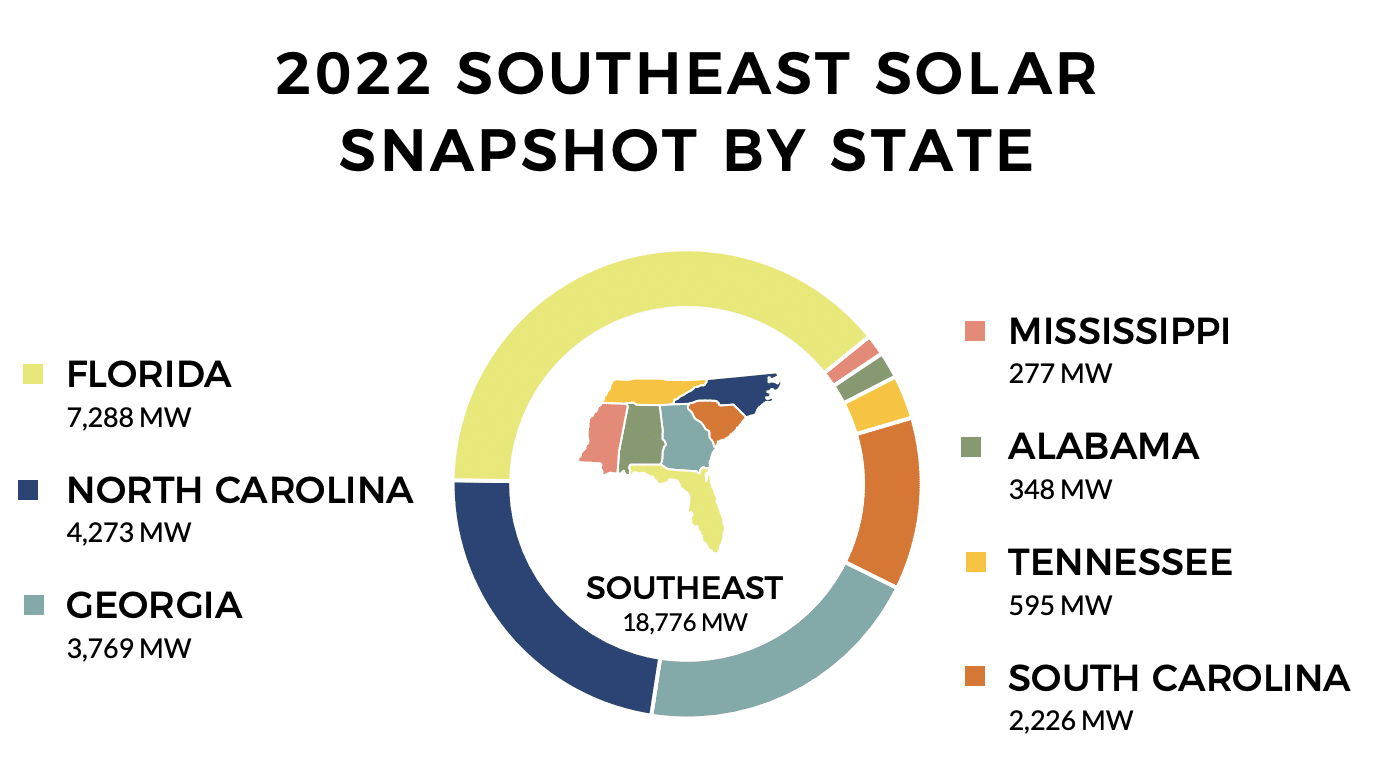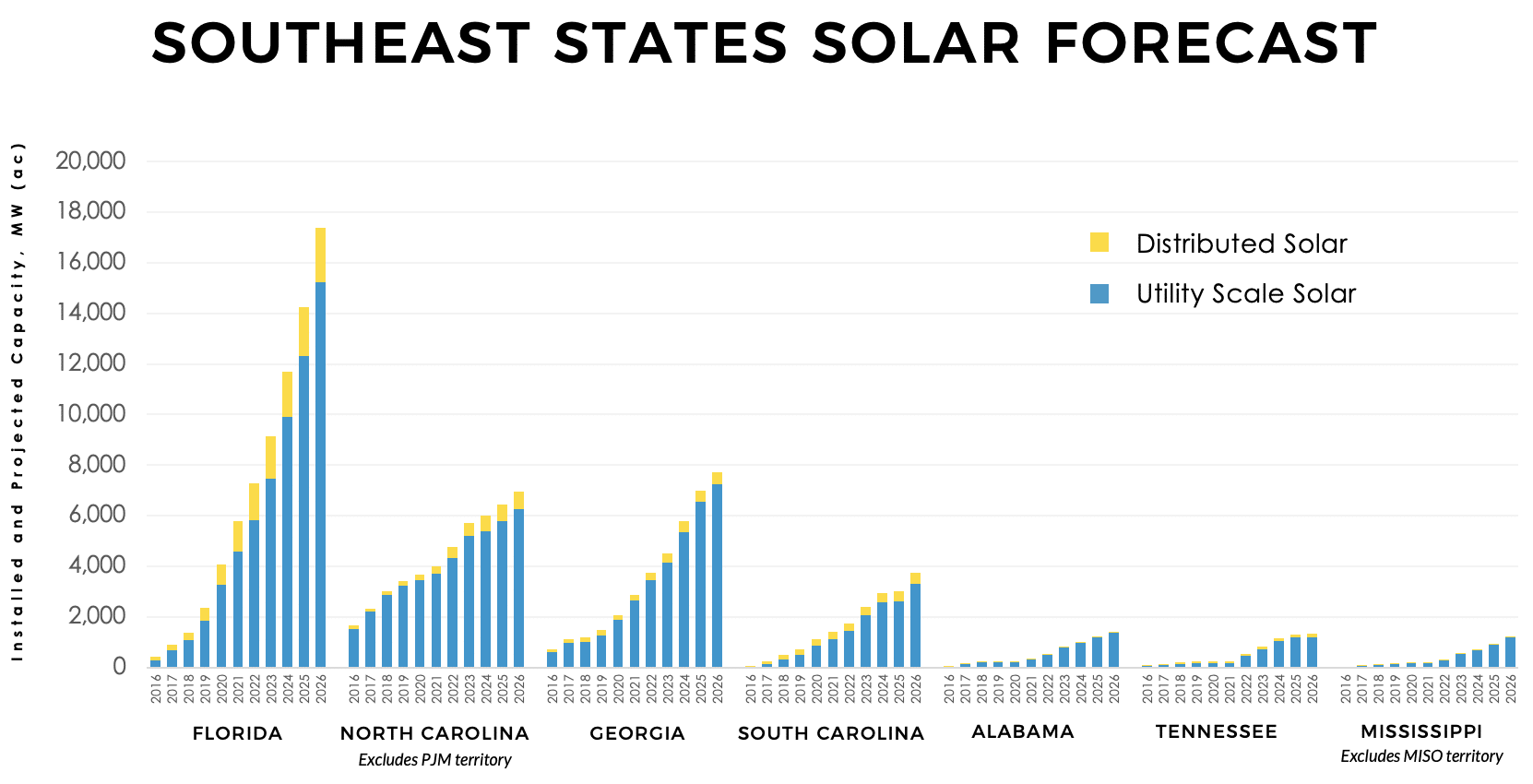SACE's annual "Solar in the Southeast" report ranks our region's largest utilities. In the fourth blog post of the series, we focus on the individual forecasts for each of the states in our region.
Bryan Jacob | July 19, 2023 | Energy Policy, Solar, UtilitiesReaders will know that the primary metric SACE uses for our “Solar in the Southeast” report is a watts per customer (W/C) solar ratio. But as also explained in the Introduction, we have also calculated a 2026 forecast for the total installed capacity of solar power (in megawatts, MW), particularly for state comparisons. And that’s what we’re examining in the fourth blog post associated with our sixth annual “Solar in the Southeast” report blog series.

Download the Report Watch the Report Webinar Read the Report Blog Series
Let’s start with the current baseline from last year (2022). The seven-state Southeast region had over 18 GW or 18,776 MW of solar on a full-year, operational equivalent basis* in 2022.

Florida is far and away the Southeast solar leader in total installed capacity – triple that of South Carolina, twelve times that of Tennessee, etc. And that lead gets even wider when we look at the next four years.
Note: The historic and forecast solar ratio (W/C) for each of the states is illustrated on page 11 of the report. And I already included that in the second blog post of this series. I’ll leave today’s post purely about the total capacity (MW).

As indicated above, based on current utility plans, Florida is forecast to have more than double the solar capacity of even North Carolina or Georgia by 2026. Much of that increase is due to ambitious solar plans at FPL – early stages of the NextEra “Real Zero” program. FPL will add almost 6 GW of utility-scale solar during this four-year timeframe. Other Florida utilities are accelerating their solar deployment, as well: Duke Energy Florida will add more than 1 GW, Tampa Electric will add more than 500 MW. Additional details are available in the Florida state profile (pages 13-14 of the report).
As we have indicated previously, Georgia is forecast to overtake North Carolina within this time horizon. This reflects the continued expansion of solar in Georgia by Oglethorpe Power/Green Power EMC (primarily for Meta). It also includes solar that was part of the Georgia Power Integrated Resource Plan from 2019, where the utility was ordered to incorporate 2,000 MW of utility-scale solar and 210 MW of distributed solar. Distributed solar from the more recent 2022 Georgia Power IRP is also incorporated (200 MW in 2024-2025), while the vast majority of utility-scale solar from the 2022 IRP will appear in future reports in the 2026-2029 timeframe.
The initial Carbon Plan adopted by the North Carolina Utilities Commission (NCUC) at the end of 2022 raises solar ambition for the state in 2030 and 2035, but Duke’s prior Integrated Resource Plans (IRP) reflect more solar in the near-term through 2026 so that plan is still reflected in the SACE forecast. We do, however, expect to see additional near-term solar when Duke Energy files its combined Carbon Plan and IRP (CPIRP) later this year – and we will update our forecast accordingly for the next report.
This latest forecast for South Carolina anticipates approximately 1 GW of new solar by Central Electric Cooperative and Santee Cooper. Alabama, Tennessee, and Mississippi still fall far short of the solar ambition in the other states.
The Alabama forecast includes projects in Alabama Power service territory:
- 400 MW for Wells Fargo, Southwire, Mercedes-Benz, and Novelis
- 200 MW North Alabama Solar Project in TVA’s service territory
- 30 MW project Huntsville Utilities has commissioned for Toyota
- 100 MW Blackbear 1 solar project that was recently completed for the Alabama Municipal Electric Authority (AMEA).
The Mississippi Public Service Commission has approved a variety of solar projects across that state. Some of those are for Mississippi Power; some are for TVA; and some are outside the SACE Southeast region.
Tennessee is almost exclusively served by TVA which has recently indicated it expects to sign contracts for up to 6 GW of solar. TVA is also in the earliest stage of its next IRP – just recently soliciting “scoping comments.” As we say in the report, “[t]his is another tremendous opportunity for TVA to exhibit the kind of leadership that the nation’s largest public power entity should.”
No doubt, SACE expressed optimism in this year’s “Solar in the Southeast” report. That’s underpinned by the current plans in some of the leading states as well as the hopeful signals and the significant opportunities for some of the lagging states. The Inflation Reduction Act (IRA) is already having a positive impact on solar in our region and there’s a lot more to come.
*For more information, see the Data Sources, Methods, and Assumptions section of the report.
Download the Report Watch the Report Webinar
#SSR2023